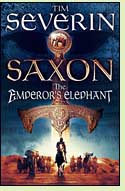The Emperor's Elephant
by Tim Severin
Reviewed by David Maclaine

The great charm of The Emperor's Elephant is its look into the mentality of a bygone age, when creatures now extinct walked the earth, but wild fantasy still crowded the received knowledge of natural history. In this second novel in the Saxon series, Charlemagne sends Sigwulf, the narrator, on a mission to secure rare animals from distant lands and transport them to Haroun al Rashid, Caliph of Bagdad. The dream-interpretation handbook in the first Saxon novel, The Book of Dreams, continues to aid him, along with his Moorish companion Osric. Another key companion is Walo, the simple-minded son of the emperor's verderer. Walo's deep empathy for animals makes him an unparalleled handler. That's a crucial skill for this mission, complicated by the fact that the emperor's knowledge of the animal kingdom derives from a bestiary which includes fabulous creatures like griffins and unicorns and myths like the tears shed by crocodiles. Another complication is a mysterious enemy who seems determined to thwart their mission - intrigue at the simpler end of a spectrum whose other extreme is the devilish complexity of Dorothy Dunnett.
Author Tim Severin has done more than his share of traveling,
his claim to fame being a series of expeditions retracing the routes of figures
of legend and history, from Jason to Genghis Khan. He honed his craft writing
books about those journeys and has mastered the process of taking his narrator
from point A - in this case Charlemagne's court in Aachen - to points B, C, D
and E with basic but sufficient literary skill. Points B, C, D and E in The Emperor's Elephant are a
Scandinavian trading port called Kaupang, Rome, Baghdad, and the coast of what
we now call Madagascar. As Sigwulf's travels introduce him to astonishing
creatures, readers learn that to discover the truth behind a myth is not always
the same as debunking it. (2013, 384 pages)
Other novels about elephants:
An Elephant for Aristotle by L. Sprague de Camp (1958), about a man who undertakes a mission for Alexander the Great which involves a journey across the known world. More info
The Elephant's Journey by José Saramago (2008), about the travels of a group taking an elephant from Portugal to Austria as a wedding present to Archduke Maximilian in 1551. See review or more info at Powell's Books
Water for Elephants by Sara Gruen (2006), about Depression-era circus performers and a circus elephant. More info
Nonfiction about Charlemagne:
Becoming Charlemagne: Europe, Baghdad and the Empires of A.D. 800 by Jeff Sypeck (2006). More info
Charlemagne's Courtier: The Complete Einhard edited by Paul Edward Dutton (9th century; this edition 1998). More info
Charlemagne by Derek Wilson (2006). More info
Online:
An Elephant for Charlemagne, an article by Jon Mandaville at Saudi Aramco World magazine.
Back to Medieval Europe: 500 -1066 A.D.
Back to Directory of Book Reviews